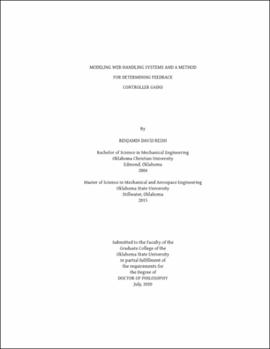| dc.contributor.advisor | Reid, Karl N. | |
| dc.contributor.author | Reish, Benjamin David | |
| dc.date.accessioned | 2021-02-22T22:24:13Z | |
| dc.date.available | 2021-02-22T22:24:13Z | |
| dc.date.issued | 2020-07 | |
| dc.identifier.uri | https://hdl.handle.net/11244/328624 | |
| dc.description.abstract | Modeling the longitudinal dynamics and control of web handling systems requires accurate models of the primitive elements involved, and an understanding of the processes used for speed and tension control. Primitive elements in a web line are the motors, the rolls of material, the idle rollers, and the web itself. Each primitive element has a simplified mathematical model at its heart. Modeling feedback control systems used for accurate control of speed and longitudinal tension in a web line require models of the web line. A systematic method for determining the controller gains for the speed and tension control systems in a web handling system is discussed along with the gain calculation method residing in the web line software, the Rockwell method. The Rockwell and the Routh Approximation methods are compared and found to have similar performance with Rockwell having better tension control while the Routh Approximation method has better speed control. | |
| dc.description.abstract | Results from experiments on the Euclid and High-Speed Web Lines are used to validate the models of the primitive elements. Simulations of experiments are used to validate the simulation tool. Simulation is used to show the effect on tension from a parameter study on span lengths and the effect on tension of changing a feedback device from a load cell to a dancer. | |
| dc.description.abstract | Slip is not distinctly a roller or a web problem, but a problem at the interface of the web and roller, which affects the assumptions used to derive primitive elements. Experiments show the presence of slip in certain circumstances and that different mechanisms of slip occur depending on operating conditions and certain parameters. Simulations of the Euclid Web Line show the effect of including the Ducotey-Good traction model. Experiments show the Ducotey-Good traction model is the appropriate mechanism of slip based on the speed of the roller at certain conditions, while at other conditions the Sliding-Friction Driven Roller model is the mechanism. The research finds a unified slip model is needed. | |
| dc.format | application/pdf | |
| dc.language | en_US | |
| dc.rights | Copyright is held by the author who has granted the Oklahoma State University Library the non-exclusive right to share this material in its institutional repository. Contact Digital Library Services at lib-dls@okstate.edu or 405-744-9161 for the permission policy on the use, reproduction or distribution of this material. | |
| dc.title | Modeling web handling systems and a method for determining feedback controller gains | |
| dc.contributor.committeeMember | Jacob, Jamey | |
| dc.contributor.committeeMember | Kamalapurkar, Rushikesh | |
| dc.contributor.committeeMember | Mantini, Lisa | |
| dc.contributor.committeeMember | Hagan, Martin | |
| osu.filename | Reish_okstate_0664D_16883.pdf | |
| osu.accesstype | Open Access | |
| dc.type.genre | Dissertation | |
| dc.type.material | Text | |
| dc.subject.keywords | control | |
| dc.subject.keywords | modeling | |
| dc.subject.keywords | simulation | |
| dc.subject.keywords | slip | |
| dc.subject.keywords | web handling | |
| thesis.degree.discipline | Mechanical and Aerospace Engineering | |
| thesis.degree.grantor | Oklahoma State University | |
